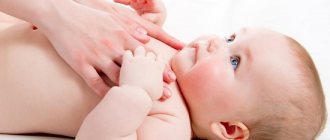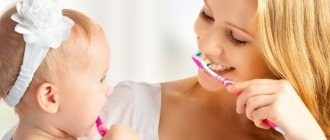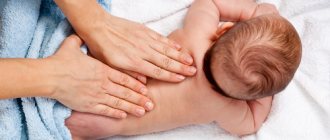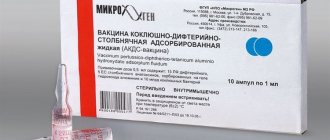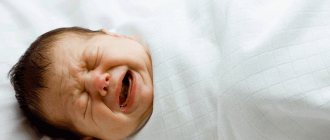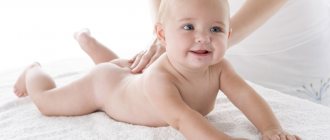Very often, parents ask a simple question: does a child under one year old need a massage? And if so, which one? After all, it is obvious that there cannot be a universal complex for all babies in the world. Let's try to figure it out.
It is absolutely clear that a healthy child will grow up without massage. On the other hand, if the developing body receives feasible stress, it will have more developed muscles, stronger bones, a trained cardiovascular system, a well-balanced nervous system and a system of endocrine glands. The function of the digestive system will be adjusted and regulated earlier. “Structure determines function,” osteopaths say. Therefore, competent massage and gymnastics will not hurt children. Well, for those kids who have been diagnosed by a pediatrician, neurologist or orthopedist, massage is indicated more than others. For many early childhood problems, a good massage can help, often even better than medication.
But here the question of the massage therapist’s qualifications arises. How can parents who are experiencing baby massage for the first time evaluate the work of a specialist? How to understand that the procedure will benefit their child and will not cause harm?
Benefits with tears?
There is the most accessible and most important criterion for assessing the work of a massage therapist. He should not be “screaming” when the child starts screaming from pain and anxiety. Before you argue with this statement, pick up any book on baby massage. One of the contraindications to performing or continuing the massage procedure is the child’s incessant screaming. It’s not for nothing that they say about a good pediatrician or a good children’s massage therapist: “Children love him!” And children love a person who loves them and treats them with respect. And it certainly doesn’t cause them pain.
I heard from one children’s masseuse with extensive practice, working in this field for two decades, the following phrase: “I’m so tired of these children’s screams!” In response, I advised her not to hurt the children. She was surprised, because there is a strange stereotype in children's massage: if the massage therapist did not “sweat,” then he probably cheated. I assure you, there is no direct connection between the number of kilojoules spent by the massage therapist and the benefits of the procedure.
The mother of one little girl recounted to me a dialogue with her friends. She was asked: “Well, are you getting a massage?” “Yes,” the girl’s mother answers. “Yelling?” "No". “Then it’s not a massage!”
Massage is not needed: pediatricians debunked myths about the need for massage for babies
In the fall of 2021, pediatric neurologist Anna Ostroverkhova wrote an angry post on her Facebook page, urging parents not to give their children preventive massage (especially if the children themselves do not like it) simply because there is no such thing as a “preventive massage” at all. the rest of the world. Despite the general optionality of massage, there are benefits to it, which, however, the doctor recommends not to focus on: “It’s very cool when a mother gives a massage to her child, not because it is necessary, not so that he develops the fastest, but simply because she I like to stroke my baby because she communicates and interacts with him that way. All these nursery rhymes and nurturing of the child have deep roots, this is a wonderful way of interaction and relaxation for the baby. But not more. I often come across mothers who say with a feeling of guilt that they missed yesterday and didn’t give their child a massage. This shouldn’t happen.”
In 2021, in an interview with the XX2 Century publication, Moscow pediatrician Sergei Butriy also spoke about the absence of any need for physiotherapeutic procedures (massage, infant swimming and fitball exercises) for infants and their parents: “I would really like to see the results of studies that would have proven the objective health benefits of such exercises, not in the rehabilitation of severely ill patients, but as a routine recommendation for all children. Until then, I will consider these things simply ways to spend time with my child, and not medical techniques. Personally, I don’t really like the fashion for swimming pools and fitballs, because not everyone has enough money for such a pastime and space in the apartment for a fitball, which means that some of those who cannot keep up with the fashion will begin to consider themselves bad parents and suffer from feelings of guilt , which I really wouldn’t want.”
In his book “Pediatrics,” published in 2021, the leading specialist at the GMS Clinic, Fedor Katasonov, wrote: “Any medical and paramedical (massage, for example) measures must be based on specific indications and have proven effectiveness and safety.”
Recently, a post by pediatric neurologist Elena Odintsova was published on the page of the Ukrainian clinic “Pediatric Plus” on Facebook, in which she debunks the main myths about the benefits of preventive massage for everyone. Here they are:
Myth 1: Massage helps a child develop better. If it is worth talking about the positive impact of massage on a child’s development, it is only in the context of forming a bond between parent and baby. All the proven benefits of infant massage (weight gain, pain reduction) appeared only if the massage was performed by the child’s mother. And as you can guess, the point here was not in her professionalism as a massage therapist, but in her interaction with the child, with tactile contact, with attention to him. “Infants who experience more physical contact with their parents show higher levels of emotional regulation and cognitive skills. And this is not about massage, this is about love))) Therefore, the most valuable thing is reciprocity in touching, communication and play! Hug, carry, kiss your babies!” writes Elena.
Myth 2: Massage helps a child learn new skills faster. At the moment, there is no evidence that professional massage can make a child develop faster and better. What can you do to help your baby learn to roll over, sit or crawl? As always, there is only one recipe: “Mastering skills occurs only through constant personal experience, making active movements in a timely and properly organized environment. For kids, this is being in the “floor play area,” since the floor is the best developmental surface.”
Myth 3: Massage helps reduce hypertonicity or increase hypotonicity in an infant. Muscle hypertonicity is a normal condition for most children under 3 months; it gradually normalizes as the child grows and develops. Also, tone depends on various other factors: constitution, type of nervous activity and physiological state of the baby. Some children are more excitable from birth and react more strongly to external stimuli, others are more phlegmatic and relaxed. Anything that goes beyond the age norm (hypertonicity or hypotonicity) is diagnosed by a specialist, may be a symptom of damage to the central nervous system and requires drug treatment and, in some cases, therapeutic massage, which is prescribed individually. “This does not mean that massage has no place in rehabilitation. It is important to understand what effect we expect from a massage and not attribute to it properties that it does not have! In modern medical science, massage is not a medical procedure and is used as a SPA procedure,” says Elena.
So if you become the owner of a healthy baby who seems to you to be too active or, on the contrary, too lazy in mastering skills, it is better to just cuddle him more often, and then send him to the safe floor - to practice new skills and spend irrepressible energy. And spend the money set aside for a massage therapist on spa treatments for your mother, she clearly needs them more.
Fundamentally wrong opinion
Unfortunately, I very often hear from parents of babies that they were given or tried to have a massage using the “screaming” method. What do you think the baby would say if he could speak, or what he would do if he could stand up for himself? It turns out that they are doing “good things” to the child, taking advantage of his helplessness. What's the result? When a child screams, his muscles cannot be relaxed. If a tense muscle is stretched, microtears of the muscle fibers inevitably occur. Later, scars will appear in these places.
In osteopathy, one of the main principles is respect for the body and its tissues. Let us tell you another great osteopathic secret: the subtler and more gentle the effect, the stronger the effect. The fact is that the body protects itself and closes itself off from any aggressive influence, from any disrespectful intrusion. This is quite natural, and it’s bad when it’s not. If the body does not defend itself, it means it is already broken. Accordingly, all the forces of the “screaming massage” are aimed at fighting the body, which means they are wasted. Only the gentle, targeted impact of a competent massage can benefit the child.
Massage technique on various parts of the body
Feet
- Infant foot massage begins with stroking.
- Then, from the heel to the toes, the back and outside of the hand are drawn several times.
- Wave-like movements are made with the thumb.
- The outer and outer part of the heels is rubbed.
- Then they move on to light tapping with their fingertips. 8 light blows on each foot will be enough.
- After this, you can bend and straighten your foot.
Legs
- Light stroking of the legs starts from the feet and moves to the thighs. Several movements on each leg, starting from bottom to top.
- Then they proceed to rubbing with fingers closed in a ring. The leg is grasped with the thumb and forefinger of both hands. Twisting with each palm should be done with rhythmic movements up to the knee. Do not touch the dimple located under the knee. When slight redness appears, the exercise is completed. The outer part of the thigh is rubbed with the pads of the fingers.
- From 4 months, kneading of the leg muscles begins. Exercise "Felting". The leg is clasped with the palms so that the palm of one hand is on the inside of the leg, the other on the outside. When rolling your baby's leg, you need to move from bottom to top. The foot massage ends with stroking movements.
- Bend the legs and raise them to the sides (develops the hip joint).
- Leg muscles can be strengthened with the following exercises. Grasping the leg with your hand, you first need to straighten it and then bend it at the knee. Place your foot on the surface and slide it. If doing a leg exercise is difficult, you should postpone it to a later period. For now, you can simply tap your baby’s foot on a hard surface.
Stomach
- Start with light circular strokes in a clockwise direction.
- Make simultaneous stroking with both hands in opposite directions.
- The palms of both hands are directed towards each other.
- Rubbing with fingertips. Can be done in any direction: clockwise, diagonally, in a spiral.
Rib cage
- Lightly stroking the surface of the sternum.
- Rubbing with fingertips from the middle to the axillary area.
- Then along the middle part from bottom to top and towards the shoulders.
- The pace can be increased. Pressing with your fingertips, move from the middle to the side surface.
- Finish the massage with stroking movements.
Hands
- Begin the hand massage with the hands. To do this, fix the hand of one of the hands with the palm and make circular movements.
- After this, each finger is massaged from base to tip.
- Next the shoulders are massaged. They are stroked in the direction from the hand to the shoulder. Then you can do a ring rubbing.
- Hand exercises will strengthen your muscles and gripping skills. The thumb is placed in the child's palm. After this, the arms rise and fall smoothly.
- The child's arms are spread to the sides, and then connected and crossed on the chest.
- Pull the baby's arms forward. Then bend one handle and straighten the other at the same time.
Back
- Stroking and rubbing begin from the lower back. Rubbing can be done clockwise, or in different directions from the spine with both hands.
- When the baby is 4 months old, you can do the sawing movement. The backs of the palms are placed on the baby’s back at a short distance from each other. Movements are carried out in opposite directions.
This massage course lasts 10 days. We must not forget about poems, songs and simple communication.
https://youtu.be/aluvE9lLwrY
Psychological trauma
Brutal violence, which is a “screaming massage,” harms not only tissues, it especially traumatizes the child’s psyche. In the subconscious of such a child it will be written in bold type: “I am defenseless, strangers can come and do what they want with me. Mom doesn’t care about my cries for help or she’s not able to help.” It is unlikely that such a child, when he grows up, will tell his parents about his problems or ask them for help in some matter.
The massage therapist must respect the baby’s personality. Even in the womb of the mother, the child has his own temperament, his own character, and habits unique to him. Women who are carrying more than their first pregnancy can say, for example, by the behavior of the baby in the stomach: “The first one was a philosopher, but this one is a naughty one!” Babies in their mother’s belly feel their mother’s mood well, experience stress with her, and do physical exercises with her (the babies of athletes who continue training are born with well-developed muscles). Already in this period, personality formation occurs. Violence against individuals is unacceptable.
The main component of baby massage is love. Without this component, what is called massage is a fiction.

